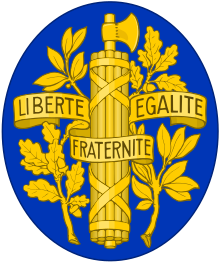Temple of Janus (Autun)
The "Temple of Janus" is a Romano-Celtic religious structure located in Autun, Saône-et-Loire, France, to the North-West of the ancient city of Augustodunum.
Temple de Janus | |
The remains of the cella as seen from the South-West. | |
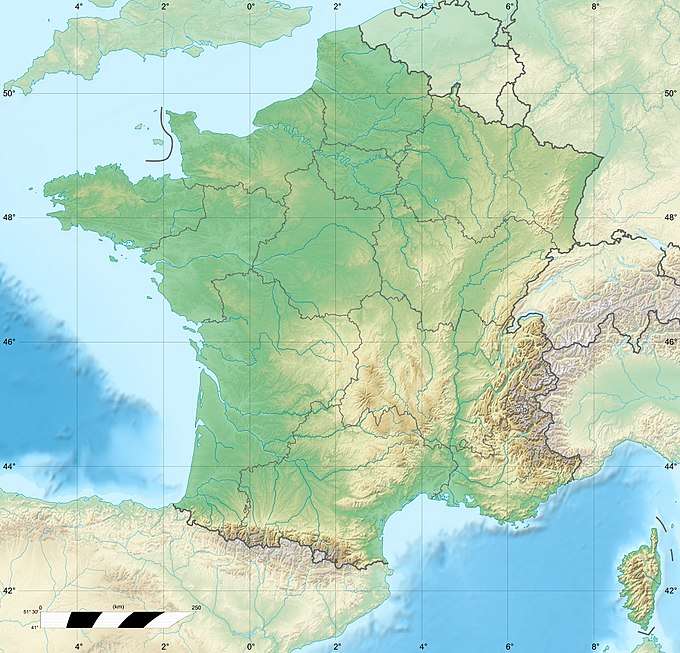 Shown within France | |
| Location | Autun, Saône-et-Loire,France |
|---|---|
| Region | Bourgogne-Franche-Comté |
| Coordinates | 46°57′16″N 4°18′57″E |
| Altitude | 290 m (951 ft) |
| Type | Romano-Celtic Temple |
| Length | 16.80 m (55.12 ft) |
| Width | 16.35 m (53.64 ft) |
| Height | 24 m (78.74 ft) |
| History | |
| Material | Sandstone |
| Founded | 1st century CE |
| Abandoned | Middle Ages |
| Periods | Classical Antiquity |
| Cultures | Aedui, Gallo-Roman |
| Site notes | |
| Excavation dates | 1970s, 2000s |
| Condition | Ruined |
| Ownership | Public |
| Public access | Yes |
| Designated | 1840 |
The temple lies in the center of a vast sanctuary, whose extent and complexity was revealed by excavations conducted between 2013 and 2016. The site's history dates back to Neolithic times and underwent an important phase of monumental construction in the 1st century CE. The temple was abandoned at the onset of the Early Middle Ages, and its structures were later reused in the fashioning of a Medieval defensive work. The temple has retained two sides of its square cella at a height of over 20 meters, as well as vestiges of its ambulatory and side structure foundations. The temple's supposed dedication to the Roman god Janus is not based on any archaeological or historic fact, and the deity that was venerated in the temple is unknown.
The Temple of Janus was included on the first list of protected historical French monuments, established in 1840.[1]
Location
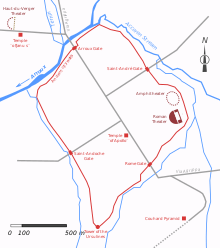
The temple was built outside the walls of the ancient city of Augustodunum, in a place known as la Genetoye.[1] It sits beside a road that passed through the Arroux gate, crossed the river, and headed West towards Lutetia (Paris), the valley of the Loire, and Cenabum (Orléans).[2][3]
The site sits at an average altitude of 290 meters, atop a plateau that gradually slopes downward towards the valleys of the Arroux to the South and the Ternin, one of its tributaries, to the East.[4]
History
The temple's history is inseparable from a broader context. The site of la Genetoye had been used since Neolithic times without any notable interruption until the Middle Ages.[5]
Geophysical exploration and aerial photography have demonstrated the existence of a vast Neolithic enclosure, accompanied with layouts whose functions are ill-defined.[6] On-site excavations over the course of 2012 have revealed the presence of La Tène usage which lasted up until the Augustan age. Some outlines, whose nature and function have yet to be determined (perhaps an earlier religious structure), have also been found within the footprint of the temple. They are dated to the first half of the 1st century CE.[7]
The Haut-du-Verger theater, discovered in the same area in 1976[8] and excavated the following year, provides an additional structure in this area.[9] The principle monuments of the site, the theater and Temple of Janus, appear to have been constructed in the second half of the 1st century or at the onset of the 2nd century,[10] with later modifications and adjustments. The site could have hosted a military presence at the end of the third century, beyond which period no convincing evidence has been recorded.
In the Middle Ages, the cella of the temple was reused for the construction of a fortification that included a ditch. This reuse may partially explain the temple's good state of preservation.[11]
The Temple of Janus was designated as a monument historique in 1840.[1]
Description
The Temple of Janus probably dates back to the second half of the 1st century CE, like the other principal monuments of Augustodunum.[12]
While it is an ancient temple, its purported dedication to the cult of Janus is without evidence. The deity to which the temple had been consecrated remains unknown. The name of Janus could simply be a corruption of the toponym Genetoye[13] (meaning a place where broom, genêts in French, was said to grow since the 16th century[14]). A historical marker near the temple explains:
To the North-West of the ancient city, on the right bank of the Arroux, grew a district whose sole visible vestige is the temple "of Janus", underlining its cultic vocation. ... The particular form of this temple, called a fanum,[15] is of the Gaulish tradition even though its architectural technique, datable to the 1st century of our era, was Roman. The name of Janus had been incorrectly ascribed to it in the 16th century by the historian Pierre de Saint-Julien de Balleure, who thus interpreted the name of the sector where it was erected: La Genetoye. This term in fact references an area where broom (genêts) grows. The deity venerated here remains totally unknown.
Architecture
The sanctuary (cella and gallery)
The cella was built with a nearly square footprint (16.80 x 16.35 m) and its elevation reaches up to around 24 meters, a record for Gaul.[16] The walls have a thickness of 2.2 meters, built in small, meticulous stonework. The entryway must have been formed by one of the missing walls, probably on the East side.
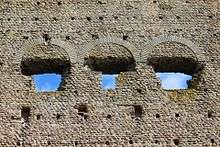
Two walls (South and West) are fully preserved, and the initial construction of the other two walls is still visible. The surface of the walls is entirely made up of small, square sandstone rubble with no terracotta inclusions, and the putlog holes that had supported the scaffolding are still visible. The core of the wall is composed of blockage and rubble mortared in Roman concrete.[17] The wall was probably opened by the cella's front door, a common placement in Romano-Celtic temples.[18] The exterior of the walls featured four rectangular niches and three small openings crowned with stone discharging arches 13 meters above ground, which illuminated the interior of the cella. The interior side of the wall was hollowed by four large, arched niches, 3 meters wide and 5.6 meters tall, but breaches in the wall now give them the appearance of large picture windows.[19] The Western wall features a semi-dome in its center, which, facing the entry, may have housed the statue of the divinity to which the temple was consecrated. The cella floor was inlaid with opus sectile, fragments of which have been retrieved, and the base of an aedicula which was installed at the cella's center is still in place. The cella would have been covered by a four-sided roof.[20]
Holes from the joists on the exterior side of the walls 9 meters above the ground, and bases parallel and 5.4 meters away from the walls, prove the existence of a covered gallery (ambulatory) which went around the cella, in accordance with the Gallo-Roman temple model observed at Périgueux with the tower of Vésone. This gallery was probably composed of columns built on the peripteros wall and supporting a sloping roof.[21]
The ambulatory
| External image | |
|---|---|
An ambulatory demarcated the sacred area around the sanctuary, as is often the case for this type of structure.[20] The dimensions proposed after the 19th century excavations (75 x 50 m) cannot be confirmed.[22] Studies undertaken in 2012 revealed the existence of two successive and concentric ambulatories, the older, perhaps featuring a portico, could have been connected to the Temple of Janus or an earlier religious structure.[7] To the South of the cella, and in the enclosure of the ambulatory, demolished walls could show the presence of an ancillary building.[23][24]
Archaeology of the temple and its surroundings

In 1871, Jacques Gabriel Bulliot undertook excavations to the North-West of Autun and around the temple which provided the basis for a detailed map drawn by Jean Roidot-Déléage.[25] Jean Roidot-Déléage also devoted eight plates of surveys and drawings to the Temple of Janus, which were not published or commented on until 1963.[26] The presumably Neolithic structures were revealed in 1886.[27] Until the 1970s, no excavations were carried out in the area of the Temple of Janus.[28]
Aerial surveys lead by René Goguey in 1976 resulted in the discovery of the Haut-du-Verger theater,[29] allowing the collection of sparse information obtained on the district, which has since been seen as a vast peri-urban sanctuary having "the function of uniting different cults of the city".[30] In the years that followed, public authorities proceeded to acquire the lands in question, finally allowing excavations to take place.[31] Aerial surveys continued until the 2000s when, in 2009, a magnetic survey finally completed the obtained data.[32] A vast archaeological dig and study site was put in place in 2012. It is expected to complete in 2016 and put forth a global vision of the la Genetoye district, both geographically and historically.[33]
Image gallery
 Detail of the niches found on the cella's interior Western wall.
Detail of the niches found on the cella's interior Western wall. Detail of the interior Western wall's semi-dome niche.
Detail of the interior Western wall's semi-dome niche.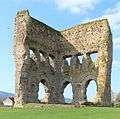 Interior view of the cella.
Interior view of the cella. Blackbirds perched on top of the cella wall.
Blackbirds perched on top of the cella wall. Western wall, face.
Western wall, face.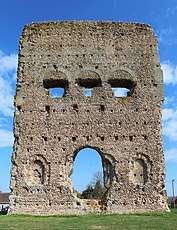 Southern wall, face.
Southern wall, face. View from South-West
View from South-West View from North-West
View from North-West
References
- Mérimée PA00113101, Ministère français de la Culture. (in French) Temple de Janus
- Nouvel (2010), (French language, external link), p. 7
- Labaune and Le Bohec (2007), (French language, external link)
- 46.96125°N 4.28828°E
- Labaune (2013), (French language, external link)
- Le complexe monumental (2012), (French language, external link), p. 21
- Joly and Barral (2014), pp. 37–38
- Devauges (1979), (French language, external link)
- Ferreira and Louis (2014), pp. 39–41
- Kasprzyk (2005), section: Fonctionnaires et militaires (French language, external link), p. 154
- Joly and Barral (2014), pp. 36–37
- Rebourg and Goudineau (1986), p. 106
- Kasprzyk, Méniel, Barral, and Daubigney (2010), section: Les données de l'archéologie (French language, external link), p. 646
- Abord (1886), (French language, external link), p. 262
- Note: In French usage, the term fanum refers to the specific type of structure represented by the Temple of Janus, although in English usage such structures are typically termed Romano-Celtic temples, as the word fanum in English has a broader sense of ancient sacred spaces in general.
- Fauduet (1993), p. 72
- Kasprzyk, Méniel, Barral, and Daubigney (2010), section: Les données de l'archéologie (French language, external link), p. 647
- Fauduet (1993), pp. 64–65
- Duval and Quoniam (1963), (French language, external link), p. 176
- Duval and Quoniam (1963), (French language, external link), p. 185
- Grenier (1957), (French language, external link), pp. 260–262
- Labaune (2012), (French language, external link), p. 129
- Duval and Quoniam (1963), (French language, external link), p. 177
- Bedon, Pinon, and Chevallier (1988), p. 125
- Labaune (2012), (French language, external link), pp. 126–128
- Duval and Quoniam (1963), (French language, external link)
- L'enceinte de Grands Champs (Autun, Saône-et-Loire), projet 2013–2015 (2012), (French language, external link), p. 4
- Vuillemot (1980), p. 81
- "René Goguey pionnier de l'archéologie aérienne en France, est décédé". L'Yonne républicaine. 24 August 2015. Retrieved 24 October 2015..
- Kasprzyk (2005), section: Les sanctuaires périurbains (French language, external link), p. 99
- Vuillemot (1980), p. 82
- Labaune (2012), (French language, external link), p. 123
- Labaune and Pasquet (2012), (French language, external link), p. 8
Bibliography
| Wikimedia Commons has media related to Temple of Janus (Autun). |
- Abord, Hippolyte (1886), Dejussieu (ed.), Histoire de la Réforme et de la Ligue dans la ville d'Autun, 3, Autun, p. 606
- Bedon, Robert; Pinon, Pierre; Chevallier, Raymond (1988). "La fonction religieuse, temples et sanctuaires". Architecture et urbanisme en Gaule romaine: L'architecture et la ville. les Hespérides. 1 (Errance ed.). Paris. p. 440. ISBN 2-903442-79-7.
- Devauges, Jean-Bernard (1979). "Informations archéologques, circonscroption Bourgogne". Gallia. 37 (2): 454.
- Duval, Paul-Marie; Quoniam, Pierre (1963). "Relevés inédits des monuments antiques d'Autun (Saône-et-Loire)" (PDF). Gallia. 21 (1): 155–189. doi:10.3406/galia.1963.2385.
- Fauduet, Isabelle (1993), Les temples de tradition celtique en Gaule romaine, Paris: Errance, p. 159, ISBN 2-87772-074-8
- Ferreira, Filipe; Louis, Antoine (2014), "Le théâtre "du Haut-du-Verger". Résultats de la campagne 2013", in Tisserand, Angélique (ed.), Journée d'actualité archéologique en pays éduen : actes de la journée du 18 avril 2014, p. 78, ISBN 978-2-9552224-0-9.
- Grenier, Albert (1957). "Quelques traits originaux de l'architecture gallo-romaine". Comptes rendus des séances de l'Académie des Inscriptions et Belles-Lettres. 101 (3): 258–274. doi:10.3406/crai.1957.10778.
- Joly, Martine; Barral, Philippe (2014), "Recherches autour du temple de Janus (Autun, 71). Résultats de la campagne 2013", in Tisserand, Angélique (ed.), Journée d'actualité archéologique en pays éduen : actes de la journée du 18 avril 2014, p. 78, ISBN 978-2-9552224-0-9.
- Kasprzyk, Michel (2005), Les cités des Éduens et de Châlon durant l'Antiquité tardive (v. 260-530 env.) - Contribution à l'étude de l'Antiquité tardive en Gaule centrale, Université de Bourgogne, p. 400, Autun05.
- Kasprzyk, Michel; Méniel, Patrice; Barral, Philippe; Daubigney, Alain (2010). "Lieux de culte dans l'Est de la Gaule : la place des sanctuaires dans la cité". Revue de l'histoire des religions (4): 639–662. doi:10.4000/rhr.7680. culte.
- Labaune, Yannick (2012), "Découvertes inédites réalisées sur le complexe cultuel de La Genetoye à Autun", Étudier les lieux de culte de Gaule romaine - actes de la table-ronde de Dijon, 18 - 19 septembre 2009, Autun09, pp. 123–133
- Labaune, Yannick; Le Bohec, Yann (2007). "Une curieuse inscription découverte à Avgvstodvnvm (Autun – Saône-et-Loire)". Revue archéologique de l'Est. 56.
- Labaune, Yannick; Pasquet, Anne (2012), Nouvelles recherches archéologiques dans le quartier du temple dit de Janus à Autun (Saône-et-Loire), Artehis (CNRS, Université de Bourgogne et ministère de la Culture et de la Communication), p. 8.
- "Le complexe monumental de la Genetoye (Autun, Saône-et-Loire) dans son environnement. Approches diachroniques et pluridisciplinaires de la confluence Arroux / Ternin de la Préhistoire au Moyen Âge", Journée d'actualité archéologique en Autunois et en Bourgogne : 23 mars 2012, Autun (PDF), Artehis (CNRS, Université de Bourgogne et ministère de la Culture et de la Communication), 2012, p. 58, Autun12.
- Nouvel, Pierre (2010). "Les voies romaines en Bourgogne antique : le cas de la voie dite de l'Océan attribuéee à Agrippa". 20ème Colloque de l'Association Bourguignonne des Sociétés Savantes. Saulieu: 7.
- Rebourg, Alain; Goudineau, Alain (1986), "Les origines d'Autun", Les villes augustéennes de Gaule : actes du colloque international d'Autun, 6-7-8/06/85, p. 118, ISBN 2-11-080907-8
- Vuillemot, Gustave, Rapports préliminaires du colloque international d'archéologie urbaine - Tours, 17-20 novembre 1980, ministère de la Culture et de la Communication, p. 527, Autun.
External links
- "René Goguey pionnier de l'archéologie aérienne en France, est décédé". L'Yonne républicaine. 24 August 2015. Retrieved 24 October 2015..
- Labaune, Yannick. "Les fouilles programmées sur le complexe antique d'Autun "La Genetoye", premiers résultats / été 2013". Le site de l'UMR Artehis (CNRS, Université de Bourgogne et ministère de la Culture et de la Communication). Retrieved 24 October 2015.
- "L'enceinte des Grands Champs(Autun, Saône-et-Loire), projet 2013–2015". le site d'Artehis. 2012. p. 4. Retrieved 24 October 2015.
- ""Temple de Janus" [archive], notice no PA00113101". Base Mérimée. French Ministry of Culture. Archived from the original on 28 November 2015.
- Temple of Janus website (French language)
Further reading
- Carte archéologique de la Gaule 71-2 : Atlas des vestiges gallo-romains d'Autun, Paris: Maison des sciences de l'homme, 1994, p. 81, ISBN 978-2-87754-022-3.
- De Fontenay, Harols; De Charmasse, Anatole (1889), Autun et ses monuments, Autun: Dejussieu, p. 514.
- Duthu, Carine (2008), Recherches sur les élévations du temple dit de "Janus" à Autun (71) : mémoire de master "histoire et archéologie des mondes antiques", Université de Bourgogne, p. 636.
- Étudier les lieux de culte de Gaule romaine : Actes de la table-ronde de Dijon, 18 - 19 septembre 2009, Montagnac: Monique Mergoil, 2012, p. 263, ISBN 978-2-35518-029-3, Autun09.
- Kasprzyk, Michel; Méniel, Patrice; Barral, Philippe; Daubigney, Alain (2010). "Lieux de culte dans l'Est de la Gaule : la place des sanctuaires dans la cité". Revue de l'histoire des religions. 4 (227): 639–662. doi:10.4000/rhr.7680. culte.
See Also
- Aedui - Gaulish tribe that inhabited Augustodunum (Autun)
- Autun
- Celtic polytheism
- Gallo-Roman culture
- Gauls
- Romano-Celtic temple
- Roman temple
- Syncretism

